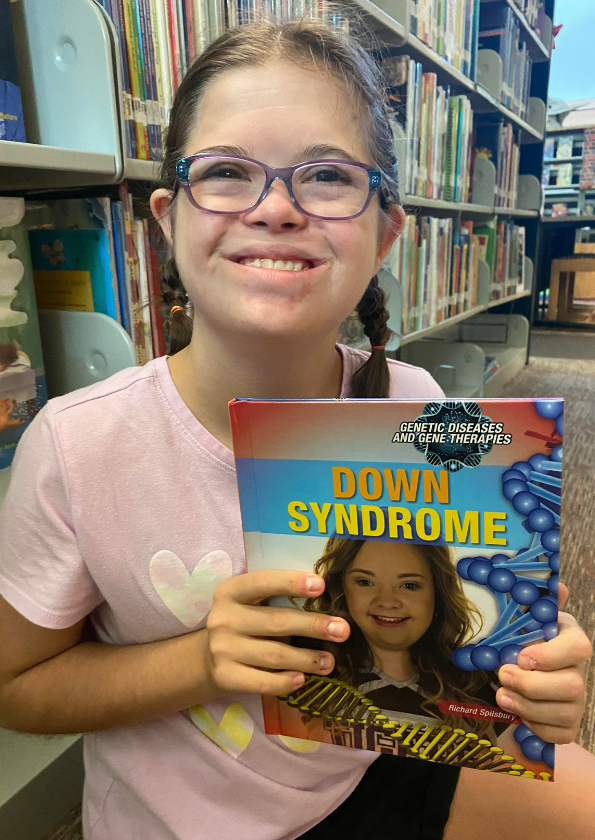As a mom to three daughters with Down syndrome, I know peer relationships between my children and their non-disabled peers can be both difficult and amazingly beautiful!
I’m made aware of my children’s differences daily by the fact that other children might stare a little longer or seem uncertain about how to interact. It’s natural for kids to be curious, but we can help our kids feel more comfortable and learn that disability is a natural part of life!
Chances are your child will encounter a peer with Down syndrome at school or in the community. How will they respond?
Here are three ways you can support your child in developing a healthy comfort level with people with Down syndrome and other disabilities.
1. Follow your child’s lead and offer support
 Photo by Sarah Basile Photo by Sarah Basile |
If you and your child are on the playground and your child notices a child with Down syndrome or another disability, observe how your child reacts. Many times young children are naturally accepting of others and may not even need your assistance!
Some children may not be sure how to respond if they can’t understand another child’s speech or if they’re not sure how to physically interact with a child who uses a wheelchair.
It’s possible you may even see your child try to avoid the other child. If you notice this desire to interact mixed with some uncertainty, introduce your child to their potential new friend and ask their name (and their caregiver, assuming they're close by!). Just as you might when meeting any new friend, point out a similarity between your child and their new friend to help them see a way or two that they’re similar.
Guide your child to directly speak to the other child, rather than the child’s parent. What if the child doesn’t answer? No problem, most kids don’t have lengthy playground conversations anyway! Invite them to play with an activity that requires little to no conversation, such as starting a game of hide and seek or follow the leader. Then step back once your child feels more comfortable.
2. Guide your child to ask non-invasive questions
Many children will have questions or comments or may even stare when they notice someone who looks different.
While it can certainly feel difficult to navigate the questions that children may ask such as, “Why does he talk like that?” or “What’s wrong with her face?” the worst thing a parent can do is to quiet their child, move them away out of embarrassment, or say, “Don’t stare!”
If your child asks these types of questions, first reflect what you’re hearing: “You noticed her words sound different than yours," for instance.
Next, explain nothing is wrong with the child, as this is often a word many children may associate with “disability.” Disability and differences are a natural part of life!
 |
About Down syndrome:
Down syndrome is the most common chromosomal disorder. About 1 in 700 babies are born with Down syndrome. People with Down syndrome have distinct facial features including almond-shaped eyes, a flattened nasal bridge, low set ears, and short stature. People with Down syndrome may have low muscle tone, making things like speaking and walking noticeably different from what children are accustomed to.
Often a parent of a child with a disability may jump in and offer some minimal information about their child’s disability, or even answer your child’s question directly. Don’t assume all parents of children with disability feel the same about answering questions. Some might be comfortable, while others might prefer not to!
Be sure to avoid asking overly personal questions! Just like anyone else, people with disabilities might feel uncomfortable being asked invasive questions especially on a first meeting!
If you notice your child’s conversation going this way, model some more typical “first meeting” questions such as, “How old are you?” or “Do you like to swing?”
Avoid saying things that show pity for the child or unnaturally pressure your child to play with the other child just because they have a disability.
Like all children, those with disabilities prefer to have genuine friendships where they feel valued.
3. Support your child’s growing comfort with the concept of disability
 Photo by Sarah Basile Photo by Sarah Basile |
Teaching your child to feel comfortable with disability shouldn’t start or end on the playground.
Oftentimes, the uncertainty your child may demonstrate around someone with Down syndrome or another disability is simply due to curiosity and a lack of exposure to those with disabilities.
Make it a priority to grow your child’s comfort level with the concept of disability outside of the playground. Perhaps you might make a trip to the library later in the week to check out some books on Down syndrome or autism and read those books together! This gives your child a chance to learn and to ask questions about disabilities at home, which is good news for everyone because that means your child will spend more time on the playground making a new awesome friend (who might have a disability) right away!
Sarah Basile lives in Greenville, S.C., with her husband and three daughters.
Want to learn more about Down syndrome?
The National Down Syndrome Society offers a Q&A for kids, fact sheets, and other resources.



